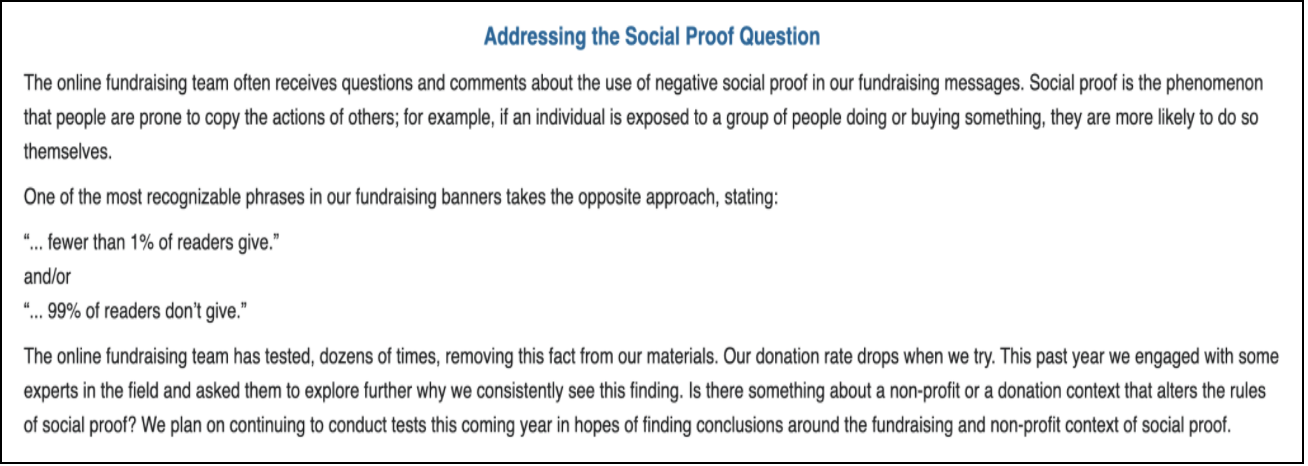15th Sept. 2021
By Hannah Chappell
Share
Exploring Social Proof Theory, Part 2: The Wikipedia Problem
Welcome back to The Behaviouralist's ongoing exploration of social proof theory. In our last installment, we discussed the basics of this phenomenon, considering how social norms are used in advertising, public health campaigns, and more. This week, we turn our attention to some of the unresolved questions that surround social proof theory and its cognitive underpinnings. To do this, we take a closer look at everyone's favourite source of fast knowledge: Wikipedia. From a blow-by-blow account of the Battle of Hastings to the precise height of your favourite celebrity, Wikipedia's appeal is ubiquitous. Boasting an average of 598 new articles every day and approximately 500 million page views daily, Wikipedia isn't suffering from a lack of traffic.
However, when it comes to fundraising, the site's advertised numbers look very different. Wikipedia's annual fundraising campaign has regularly drawn confusion and criticism for its counterintuitive use of social norms. Consider this message from the site's current fundraising drive:

Social proof theory tells us that the most effective message to increase participation or engagement is to communicate that the majority of people are already practicing the desired behaviour. Yet here Wikipedia emphasizes the opposite, telling readers that 98% of Wikipedia users do not give.
The site's commitment to this strategy has flummoxed marketing experts and behavioural scientists alike. In fact, Wikipedia's donation messaging has attracted so much confusion and controversy, that Wikipedia now includes this disclaimer statement on their fundraising page:

The Wikipedia team emphasizes that their counterintuitive messaging has repeatedly been found to be more effective than sharing no message about group participation rates. They conclude by noting that they are working with behavioural scientists to learn more about this phenomenon and how social proof theory operates when it comes to fundraising campaigns.
Meanwhile, marketing enthusiasts and behavioural scientists continue to ponder this perplexing pattern. The internet is littered with critiques and speculation as to why Wikipedia users respond to this counterintuitive approach. One Medium user writes:
To my mind, this is a case where a number of other principles of donor psychology outweigh any value social proof might have. Those principles are: identity, perceived risk, and reciprocity' (Keating, 2019). The fundraising-focused site The Agitator also broaches 'the Wikipedia problem' but does not come to any conclusions about how and why Wikipedia's bizarre use of social norms works.
So the question remains: why does Wikipedia's antithetical messaging garner participation year after year? The Behaviouralist has a few theories. For one thing, it is possible that Wikipedia's woe-is-me approach, emphasizing how few readers donate to the cause, triggers a self-directed halo effect. The halo effect refers to the tendency to overly attribute positive impressions of an individual, organisation, or brand ('Positive impressions'). For example, a company that is known for being carbon neutral may be perceived as being better than its competitors overall, even without evidence to suggest that its services are superior. This same logic may be directed internally for those who support Wikipedia: an individual may feel especially virtuous if he or she contributes to the site, since so few users choose to donate.
It is also possible that Wikipedia's proclaimed low participation rates prompt donors to perceive their contributions as more impactful. Extant research suggests that perceived donation efficacy (PDE) can have a significant impact on individuals' charitable giving (Carroll & Kackersky, 2019; Sharma & Morwitz, 2016). Consequently, Wikipedia's messaging regarding low participation rates may lead users to feel that their donations will have increased impact because of the paucity of contributions.
Finally, it is conceivable that highlighting the lack of donations stirs pity or guilt in users. Indeed, Basil and colleagues (2008) identified guilt as mediating the relationship between empathy and charitable giving. Wikipedia's fundraising campaign may prompt visitors to donate out of a sense of guilt.
In sum, it seems likely that other psychological factors, which may work in opposition to social proof theory, could be driving donors' decision-making in this instance. Wikipedia remains the only major organisation to employ this counterintuitive approach to social norms messaging, and behavioural science practitioners continue to speculate about the psychological mechanisms underlying social norms-prompted behavioural change. In our final social norms-focused blog post, we will examine new research from our team that provides novel insights about social proof theory, shedding light on why Wikipedia's unconventional messaging works.
References
Basil, D. Z., Ridgway, N. M., and Basil, M. D. (2008). Guilt and Giving: A Process Model of
Empathy and Efficacy. Psychology and Marketing, 25(1), 1-23. https://doi.org/10.1002/mar.20200
Carroll, R., and Kachersky, L. (2019). Self fundraising and the role of perceived donation efficacy in individual charitable giving. Journal of Business Research, 99, 254-263.
Keating, C. (2019). Why doesn't social proof work for Wikipedia fundraising? Medium. Retrieved from https://medium.com/@chriskfundraising/why-doesnt-social-proof-work-for-wikipedia-fundraising-65d55a047911
Sharma, E., and Morwitz, V. G. (2016). Saving the masses: the impact of perceived efficacy on charitable giving to single vs. multiple beneficiaries. Organizational Behavior and Human Decision Processes, 135, 45-54. Why do positive impressions produced in one area positively influence our opinions in another area? (n.d.). The Decision Lab. Retrieved from https://thedecisionlab.com/biases/halo-effect/

